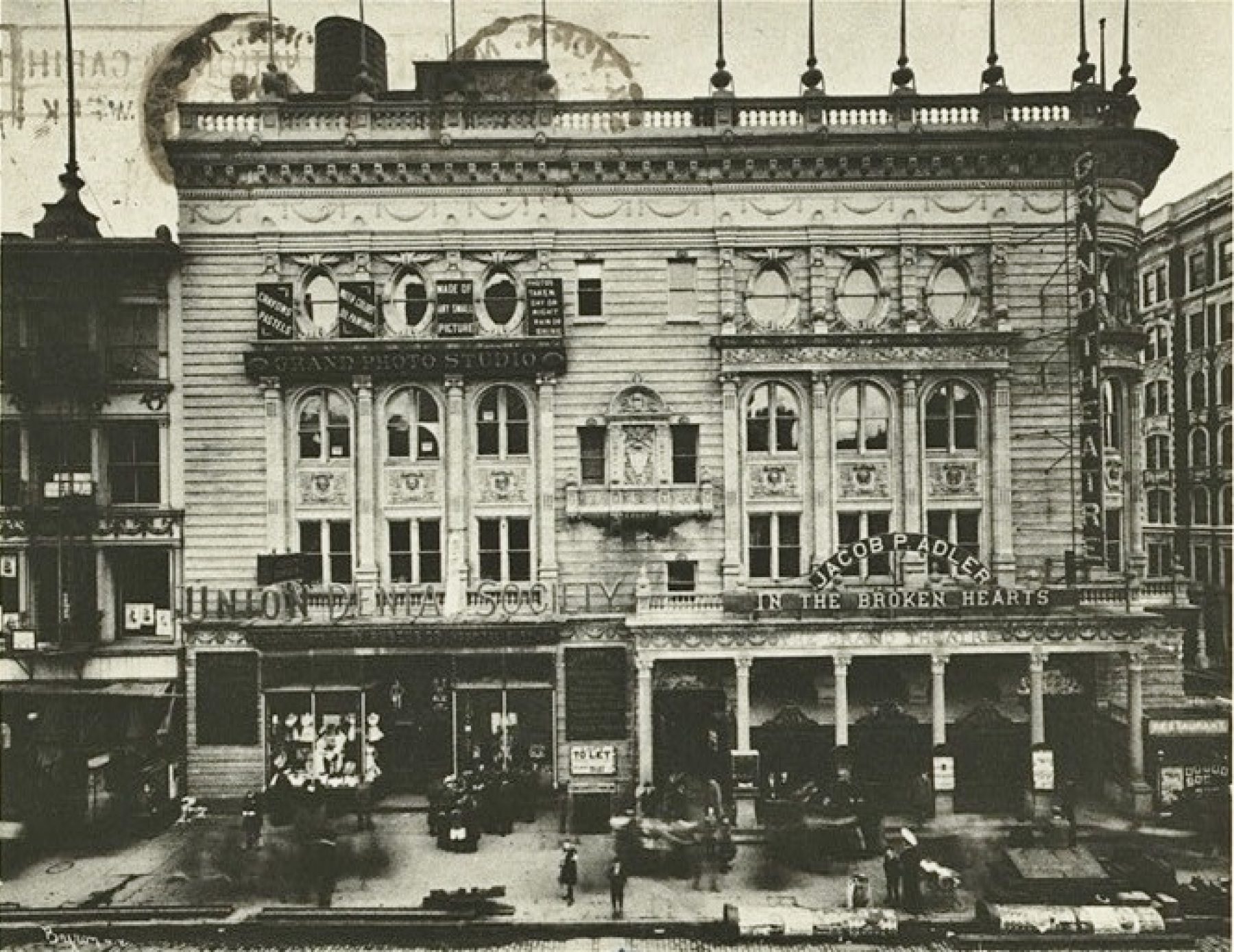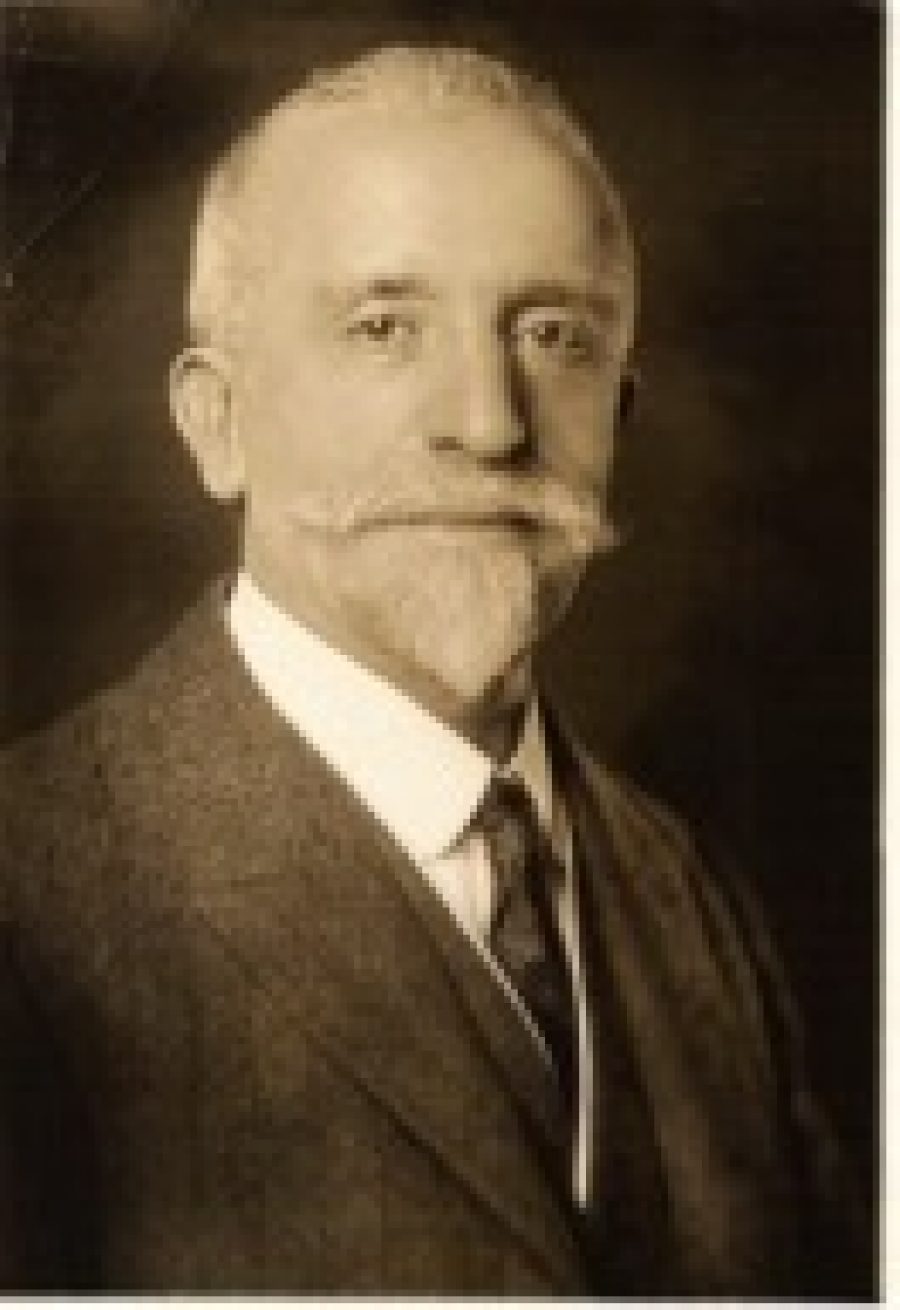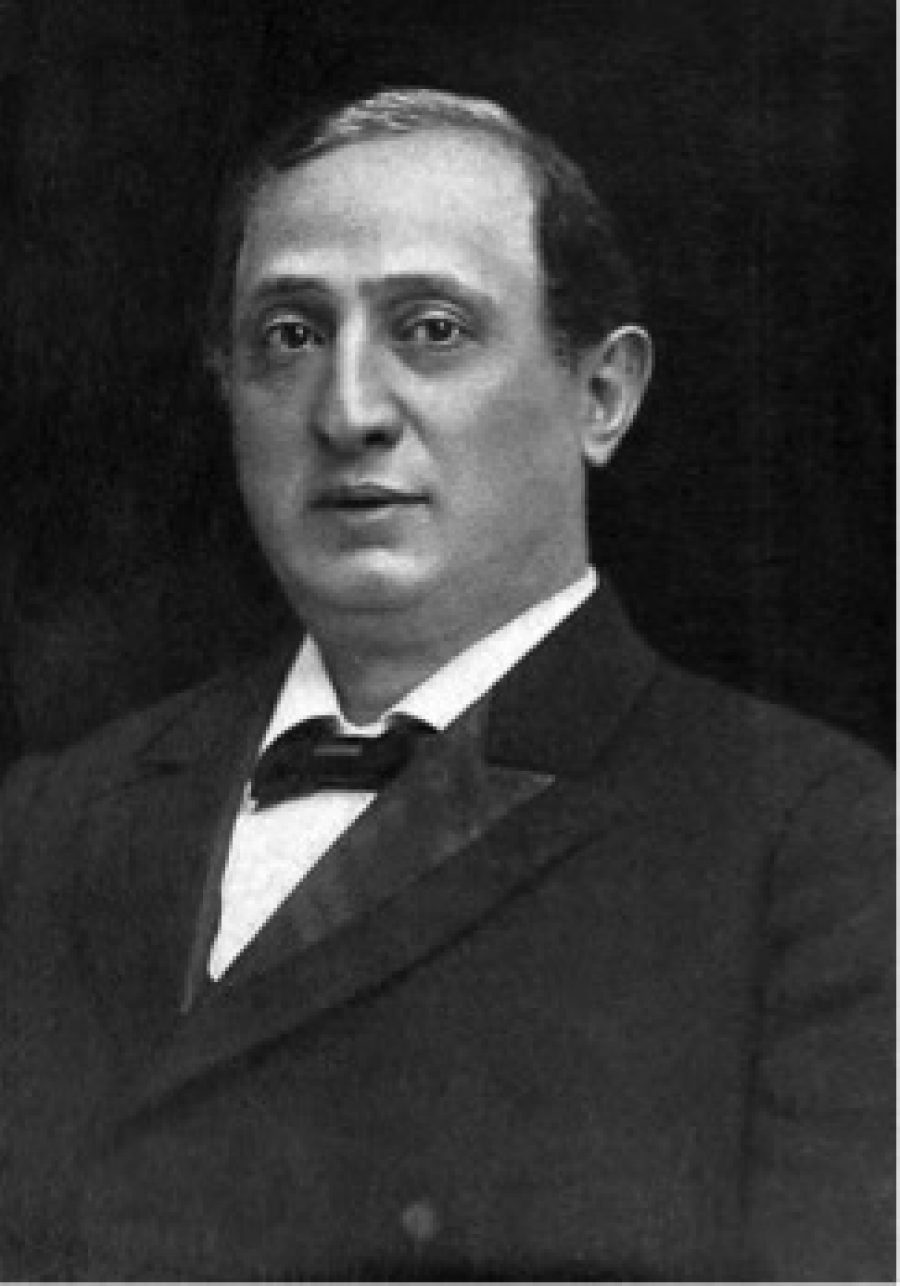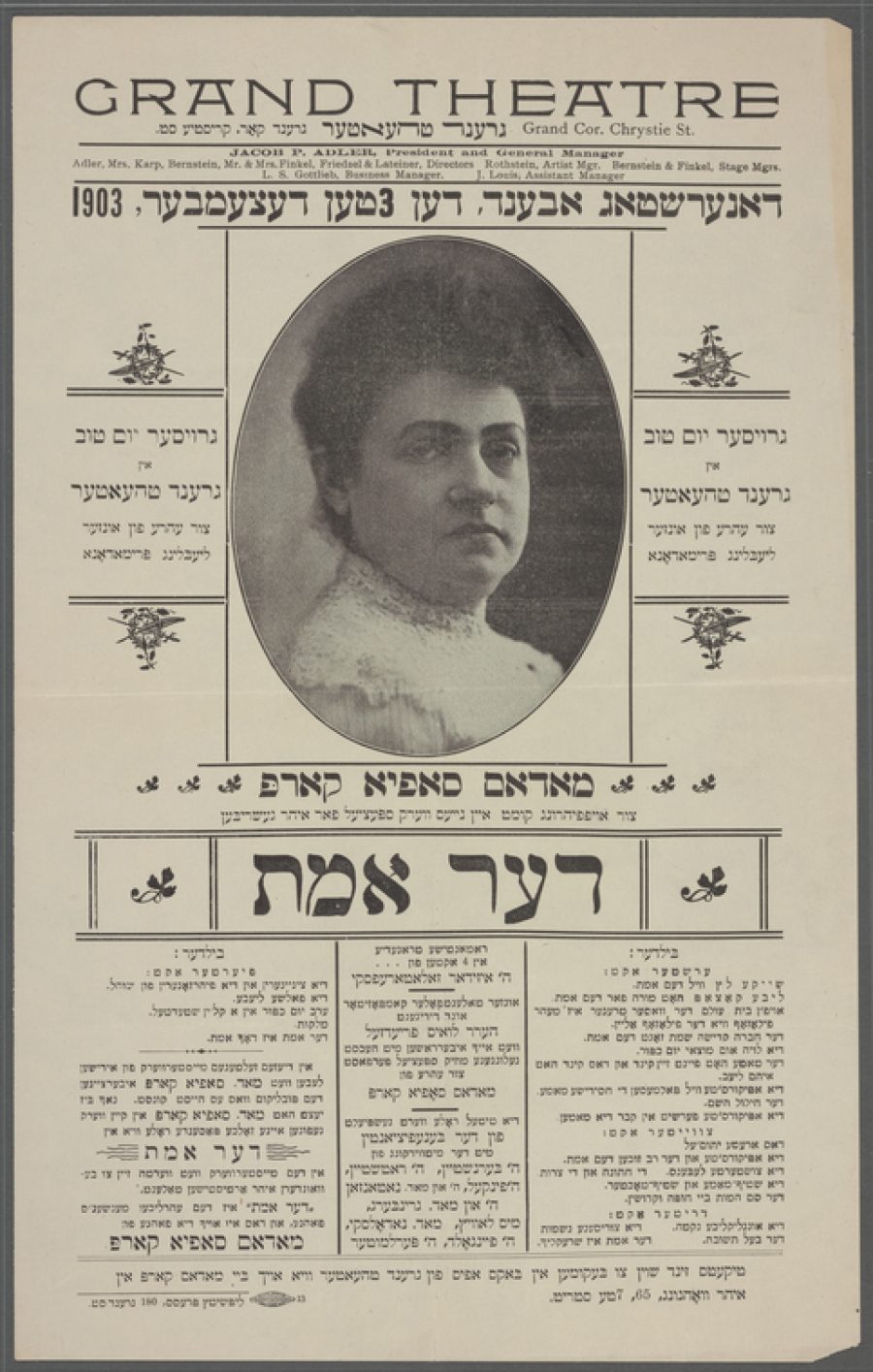
Grand Theatre, 1903 with Broken Hearts on the program. NYPL Digital Collections.
The Grand Street Theatre: A Modern Playhouse Built for Old-fashioned Shund
Judith Thissen
“A note of patriotic fervor, mingled with the pride of local achievement marked the opening of the new Grand Theatre, at Chrystie and Grand streets, last night,” the New York Times reported on February 6, 1903. The building was decorated with streamers in the national colors and shields bearing the coat of arms of the State of New York. When Mayor Low, the guest of honor, proceeded to his box, the orchestra struck up “The Star-Spangled Banner” and the entire audience, rising to its feet, joined in the national anthem. Alongside these symbols of Americanism, white and blue flags with Stars of David and the singing of a hymn in honor of the khanukes-haba’yes (the dedication of the building) stressed loyalty to Jewish traditions. So did the play of the evening: Tsiyon, oder Al nahares bovl (Zion - or the Rivers of Babylon), a historical-romantic story set in the time of the Babylon exile.
The opening night of the Grand Street Theatre was widely covered as a special event because it was the first playhouse ever purpose-built in New York for Yiddish performances. On the Lower East Side, there was indeed a great sense of pride attached to the new building. And over time, the Grand Theatre gained an almost mythic status in Yiddish theatre history and popular memory, because it was for several years the home of Jacob P. Adler and Yiddish literary drama before it was turned, in 1909, into a moving picture and vaudeville theatre. But by and for whom was the Grand actually built, and why? Archival records – especially the property deeds and leases at the Manhattan Office of the City Register – reveal the hidden history behind the Grand’s construction and the troubles that the initiators of the newly-opened playhouse faced right from the start.
Harry Fischel
The story of the Grand starts in February 1902, when real estate developer and philanthropist Harry Fischel buys a piece of land at the south corner of Grand and Chrystie streets. Fischel was an affluent Orthodox Jew who was strongly involved in communal affairs. In his biography (1928), we read that the Grand Theatre project was “neither strictly business nor strictly philanthropic, but one in which both elements were in a degree combined.” The contracts confirm that erecting the first modern Yiddish theatre in New York was not merely a charitable action. The rent of the new building was much higher than what Yiddish companies were used to paying on the Bowery. On the other hand, the property also included a café-saloon in the basement, a large store on the ground floor and office spaces on the upper floors. By subleasing these commercial spaces, the lessees could generate additional revenues. Tellingly, the initial contract contains a clause in which Fischel gives his explicit consent to the sale of “liquor or other beverages or tobacco” on the premises. As an observant Jew he may have personally disapproved of this, but he knew that theatres needed the income from such lucrative side-businesses.

Harry Fischel
Fischel hired architect Victor Hugo Koehler to design a four-story “modern fire-proof theatre … with proper decorations inside and outside.” The theatre would have all the latest conveniences: central heating, proper ventilation, and its own electrical plant in the basement. While Koehler was collaborating with Fischel to develop the Grand Street Theatre, he also was working uptown for the Shubert Brothers. For these Russian-Jewish theatre producers, who were rapidly gaining power on Broadway, he designed the Lyric Theatre at 213 West 42nd Street. There is a striking resemblance between the two theatres, although the façade of the Grand Theatre was clearly more elaborate in its neo-classical design. While the Lyric has been restored to its original grandeur and now has a landmark status, the Grand Theatre was unfortunately demolished in the 1930s.
No building records or floor plans of the Grand Theatre survived in the Municipal Archives. The files were thrown away when the building was torn down – this was the standard practice in those days. Luckily, I found in the city register an early conveyance deed, which gives a quite detailed description of the theatre that Fischel planned to build. Initially, the auditorium was designed for 1,650 seats but later sources usually mention a seating capacity of around 2,000. The best seats – those in the orchestra, dress circle and boxes - were “all of iron and nicely upholstered,” while the seats on the balcony and two galleries were of “plainer design.” Red and old gold were chosen as the main color scheme. Each floor had its own lobby, cloak room and a spacious smoking room for the gentlemen. The main entrance of the Grand Theatre was situated on the street, which gave the theatre its name, but around the corner on Chrystie Street, there was a side entrance with a separate box office and stairs leading directly to the top gallery. Thus the poorest theatre fans and the rowdy patriotn (gallery gods) 1 were separated from the rest of the audience. Quite revealing also is the distribution of sanitary facilities, which suggests that some parts of the theatre were a predominantly male preserve. Urinals and men’s toilets were located on the top gallery floor and in the basement; women’s toilets on the balcony floor and first gallery.
The Tenants
Who were the future tenants of the Grand? According to his biography, Fischel decided to build the new playhouse “at the suggestion of the great Jewish actor, the late Jacob P. Adler.” In retrospect, Fischel’s biographer and son-in-law may have found it more appropriate to associate one of the leading philanthropists of the immigrant generation with the defender of Yiddish drama as art rather than to tell the truth: Fischel’s taste was actually more like that of the Yiddish masses, with their preference for light entertainment with Jewish motifs. His plans for a purpose-built Yiddish theatre were definitely not motivated by a desire to promote literary drama or to educate Jewish workers with high cosmopolitan art. The contracts that are kept at the Office of the City Register leave no doubt that the construction of the Grand was commissioned by the actress Sophia Karp and dramatist Joseph Lateiner, two exponents of the early Yiddish theatre. Karp and Lateiner operated in partnership with kapelmayster (band leader) Louis Friedsel, comedian Bernard Bernstein, and actor-manager Maurice Finkel and his wife, the actress Emma Thomashefsky (Boris’ sister). Unlike Jacob Adler, these theatre people shared a strong faith in the old-style Yiddish melodramas and operettas of the 1880s, which the community’s cultural elite condemned for their lack of sophistication, seriousness and good taste. Also, all of them suffered from what Bernard Gorin, the first Yiddish theatre historian, called di naye ordenung oyf der bine – the new order on the stage.

Jacob P. Adler in 1902. Theater Magazine, November 1902.
In the 1890s, a new generation of actors and playwrights had come to the forefront. They promoted a more sophisticated Yiddish theatre, which broke away from the crude plays of Lateiner and Hurwitz, who dominated the early Yiddish theatre on the Bowery. Led by the playwright Jacob Gordin, the movement for an improved Yiddish theatre gradually undermined the position of the old guard. Not without reason, veterans like Lateiner and Sophia Karp, his prima donna, feared that their future was at stake. Both were connected to the People’s Theatre, where Jacob Adler and Boris Thomashefsky had successfully consolidated their power and become star-managers. In this position, they not only controlled the finances, but also selected the plays and dictated the casting of roles. In the early 1900s, Sophia Karp’s position as the leading lady of the People’s Theatre was challenged not only by the younger Bessie Thomashefsky (Boris’ wife) but also by Sarah Adler, who was a few years her senior. Thus, it is not surprising that she sought to turn the tide. Holding firmly to the idea that Lateiner’s plays could still draw the crowds, Karp persuaded Fischel to build a theatre for her new troupe. He must have been a big fan of hers, because he intended to go to the Grand regularly. The original agreement with Karp & company specifies that one box was reserved for the exclusive use by Fischel, his family, and friends “during any performance and free of any charge for admission.” Moreover, Fischel and his wife personally invested $50,000 in the project (about 1.2 million dollars today). Meanwhile, the future lessees deposited a sum of $25,000 as security. What was remarkable about the deal is that the future lessees co-owned the theatre. At least on paper, the project was legally a joint-venture between the Fischel family and the Karp-Lateiner troupe.
The Opening
The Grand Theatre was to be completed no later than September 15, 1902, in time for the opening of the new season. But the opening was delayed for several months and thus the company missed out on the Jewish holidays, when thousands went to see a Yiddish play – especially in the week of Sukkoth, which in New York City had developed into a sort of theatre festival. In addition to the loss of the regular box-office trade, the sale of benefits was seriously hampered as long as the exact opening date of the Grand remained uncertain. Immigrant associations simply did not want to take any chances that their theatre outing might be cancelled or delayed. And then when the playhouse finally opened its doors, Lateiner’s new play impressed neither the critics nor the crowd. The New York Times described the production as “a mixture of melodrama, comic and grand opera, and at times a sort of vaudeville speciality.” Zion – or the Rivers of Babylon was designed for those “who want to be simply and easily amused,” but it nevertheless failed. Clearly, Karp and Lateiner had overestimated their own box-office appeal and the fact that audience demands had changed. Immigrants were willing to pay for an expensive theatre ticket, but they expected to get more out of a visit to the legitimate theatre than the sort of variety show that they could get for half the price at a Yiddish music hall, or even for free in a concert-saloon. What made things worse is that the cheapest seats in the upper gallery offered at best a partial view of the stage – not much more than the actors’ heads. Ardent patriotn complained in vain about this situation and then decided to boycott the house. According to the New York Times, the Grand had been designed to attract “the better class of East Side Jews,” but perhaps it would have been wiser to respect the gallery gods and deal with their protests by lowering the prices on the second balcony.
The Fischels, who held a controlling interest in the Grand Theatre Company as its main stockholders, feared that the venture was doomed to fail. To protect their $50,000 investment, they bought the premises back from the company in June 1903, returning the $25,000 investment to Karp and her associates. After that, they raised the lease of the building (including the stores, lofts and basement saloon) to $32,000 per annum for a period of five years. Although the Grand Theatre Company now again disposed of working capital to keep afloat, the high rent put the Karp-Lateiner troupe in a precarious position. Ironically, their survival depended on whether or not they were able to contract a star of the new generation - someone who would bring in the crowds and the money with a more contemporary repertory. Karp and Lateiner proposed a three-year contract to Jacob P. Adler as the Grand’s new artistic director. He accepted. On Friday August 28, 1903, the Grand Theatre opened its second season with Adler starring in Der yidisher kenig Lir (The Jewish King Lear), a classic from their archenemy Jacob Gordin.
Broken Hearts
On September 18, 1903, Gebrokhene hertser (Broken Hearts), a sophisticated tearjerker about Jewish immigrant life by the realist writer Zalmen Libin, premiered at the Grand Theatre. The play was an immediate hit. For three months, Adler appeared every Friday, Saturday, and Sunday night in the role of the old world cantor whose family breaks up under the pressure of the trials and tribulations of the New World. Sophia Karp had to content herself with the weekend matinee shows. On Rosh Hashanah and Sukkoth, Broken Hearts played at both matinees and evenings. By December, Adler had given a total of 79 performances at the Grand, mostly alongside his wife Sarah. Clearly, Sophia Karp was no longer the company’s prima donna.
Had Karp and Lateiner sidelined themselves for the sake of the box-office? Or had Adler taken control? We find the first evidence of a feud between Adler and the rest of the directors in the Jewish Daily Forward of December 8, 1903. The advertisement for the Grand Theatre had a new heading: “Jacob P. Adler, president and general manager.” This small but revealing modification occurred a few days after the opening night of Der emes (The Truth), a romantic tragedy written for Sophia Karp by Isidore Zolatorevsky, an up-and-coming shund writer. The play, which was meant to put her in the spotlight again, premiered during a special benefit evening in Karp’s honor. Unfortunately, the audience had a lukewarm reaction during the opening weekend. Adler proposed to switch back to Broken Hearts, but the other directors refused to close the new play. After that, the situation rapidly escalated. We can follow the events day-by-day in the Forward, which eagerly turned the feud between Adler and Karp into a real-life melodrama.
Adler sought to take control of the Grand, but he met with fierce resistance. In the second week of December 1903, Adler was deposed of his duties as manager by a majority decision of the board. He immediately challenged this decision, which reduced him to the rank of a mere actor. With the help of a handful of policemen, Adler squatted at the Grand to defend his rights and entrenched himself in the theater’s box-office for several days. Fans spent the night with him at the Grand, eating and sleeping on the stage after the performance. They were not alone. Terrified that she might lose “her” theatre, even Sophia Karp shlepped a bed into her dressing room one night. The story goes that it was so cold that she caught pneumonia and died a few days later. But Karp was wise enough to go home when Adler turned off the heating.
On December 18, the board of directors of the Grand Theatre obtained an injunction forcing Adler to leave the building and to refrain from interfering with the company’s business. Three days later, the case was heard at the Supreme Court. Before the court, Adler claimed that “he was the boss because he paid all the salaries,” but the judge decided otherwise and put the board of directors in the right. Karp and her allies were once again firmly in control. Lateiner’s plays were put back on the bill, and for almost two months, the Adlers did not perform at the Grand. However, despite the verdict, the battle continued until early February 1904, when a bold announcement appeared in the Forward informing “everyone who loves true art” that “J.P. Adler is the one and only proprietor of the Grand Theatre – not just the bright star on the stage, but also the person responsible for everything that happens there.”

Handbill for the opening night of Der emes in honor of a not so happy looking Sophia Karp. Date: Thursday December 3, 1903. The heading already positions Adler as President and General Manager. NYPL Digital Collections.
Sophia Karp made her exit, never to return on the Yiddish stage. She died on April 1, 1904, at the age of thirty-nine. According to the Forward, Karp had invested all her energy and money in the construction of the new playhouse, because “she wanted a heym [home] of her own,” where she would not be “oppressed by the manager, the star, or his wife.” Clearly, the plan had backfired dramatically. The day of her funeral, the Grand Theatre was draped in mourning. Thousands went into the streets to pay her their last respects, but the biggest crowds were not found on the corner of Grand and Chrystie. Most fans preferred to honor Karp in front of the People’s Theatre on the Bowery, where she had her finest years as prima donna.
